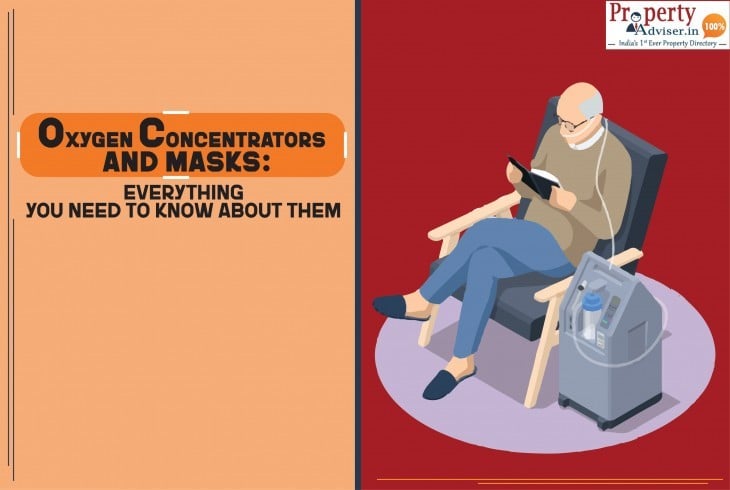The second wave of the Covid-19 pandemic has made it necessary for all of us to have basic knowledge about oxygen concentrators and oxygen cylinders.
Here is a quick guide for you to be prepared if you may need to use oxygen support at home for yourself or someone around you.
We are hearing a lot about oxygen cylinders and oxygen concentrators nowadays. Both deliver oxygen directly into the nose of patients who need it. They differ from each other with respect to the method of delivery. Read on to know what is an oxygen concentrator, what is an oxygen cylinder, how they differ, where to get an oxygen cylinder for home, and why an oxygen machine at home is better than an oxygen cylinder.
What is an Oxygen Concentrator?
An oxygen concentrator separates oxygen from room air. It is an electronically operated device (like the air conditioner) that takes in air, removes nitrogen from it and delivers a high concentration of oxygen directly to the patient through the nasal cannula or the oxygen mask. The oxygen delivered is 92-95% pure, and the flowmeter indicates the rate of flow. The oxygen concentrator should be placed in a well-ventilated area.
What is an Oxygen Cylinder?
An oxygen cylinder is a tank (like your LPG cylinder) that contains prefilled, compressed oxygen. It is a simple oxygen storage vessel, and like the oxygen concentrator, it delivers oxygen directly to the patient through the nasal cannula or the oxygen mask. Most oxygen cylinders have flowmeters to indicate the flow rate.
An oxygen cylinder is mounted on a trolley to transport it around. Medical oxygen cylinders are usually painted black all over, but white on the top part. You might have seen pictures of hospital staff or caregivers pushing trolleys mounted with oxygen cylinders back and forth in hospital corridors or in front of their homes.
Difference Between Oxygen Concentrator & Oxygen Cylinder
The oxygen cylinder is a prefilled tank containing a finite amount of oxygen. Therefore, it would need to be refilled when the oxygen in it is exhausted after being used up by the patient. Since oxygen cylinders contain compressed oxygen, they are made of heavy metal. The weight of the metal and the weight of the oxygen makes oxygen cylinders heavy and difficult to transport. Dealers may need some lead time to deliver an oxygen cylinder to you, especially during these times when the demand is high.
The oxygen concentrator is like an oxygen machine for home. It does not need any refilling, as it uses the surrounding air to deliver oxygen. It can continue functioning forever and provide an unlimited supply of oxygen, as long as it has a functional battery and there is a power supply. It would need periodical maintenance, servicing and repair like any other electronic device. Oxygen concentrators are lightweight and easy to carry around. Some models can even fit in a backpack.
Thus, an oxygen concentrator would be considered more convenient for use, if you are looking for an oxygen machine for your home. However, be advised to have additional fully charged batteries in case of a power outage. Also, people can bank on an oxygen cylinder for further backup if needed.
That said, oxygen cylinders have their own set of advantages. They do not need batteries or power supply and deliver their work silently without all those beeps that are associated with oxygen concentrators.
Also, an oxygen cylinder for home comes at a low initial cost compared to an oxygen concentrator and therefore cost-effective for short term use. When it comes to long term use, the cost of refilling/replacing oxygen cylinders will keep adding up. They may turn out to be a lot costlier than oxygen concentrators.
Cost of Oxygen Concentrator
Oxygen concentrators have higher upfront costs compared to oxygen cylinders, but they will save you money in the long run. Depending on the brand, size and model, an oxygen concentrator would cost Rs. 50,000 to Rs. 100,000+. You can refer to this list of oxygen concentrator dealers in Hyderabad. The same dealers will also provide maintenance and repair.
Cost of Oxygen Cylinder
Oxygen cylinders usually come in two sizes:
The B-type oxygen cylinder has a capacity of 10 litres and may cost Rs. 5000 to Rs. 10,000., depending on demand and supply. Depending on the flow rate, a 10-litre cylinder may last about five to six hours.
The D-type oxygen cylinder has a capacity of 47 litres and may cost Rs. 7,000 to Rs. 15,000. This is usually used in hospitals.
Current surge pricing of oxygen cylinders in Telangana because of increased demand for medical oxygen is Rs. 25,000 for the 10-litre oxygen cylinder and Rs. 35,000 for the 47-litre cylinder.
You can find listings of the top 50 oxygen cylinder dealers in Hyderabad if you need an oxygen cylinder for your home.
Difference Between Nasal Cannula & Oxygen Mask
Now we know that whether you use an oxygen concentrator or an oxygen cylinder, the oxygen is delivered into the patient’s nose via a nasal cannula or an oxygen mask.
What is the difference between a nasal cannula and an oxygen mask? Which one is better of the two?
The nasal cannula is a lightweight tube, one end of which is fixed to the oxygen concentrator and the other end has two prongs that are inserted in the nostrils of the patient.
The oxygen mask, (like the nebuliser mask), is a lightweight tube, one end of which is fixed to the oxygen concentrator, and the other end has a mask that covers the nose and the mouth of the patient.
You can use either the nasal cannula or the oxygen mask. However, the nasal cannula is more convenient as it does not cover the mouth, and therefore the patient can talk comfortably while using a nasal cannula. The oxygen mask, on the other hand, can make the patient feel claustrophobic. Also, it is not easy to talk while using an oxygen mask, since it covers the mouth.
Property Adviser is committed not just to make your house search easier but also to provide you with useful Covid-19 resources in Hyderabad. Log in to our website for all the news and updates related to Covid-19.










